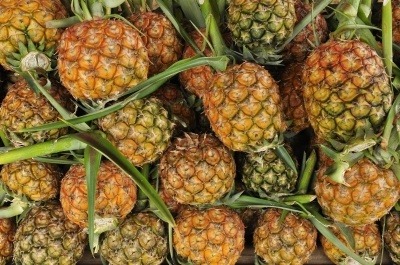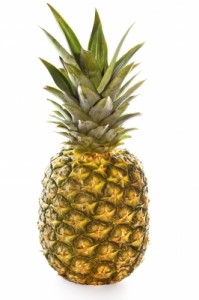
Bromelain is a name given to a protease enzyme mixture. It has been used in traditional folk medicines from ancient times but is attracting great interest because of the range of therapeutic activities it is involved with.
Bromelain has recently found favour in treating various conditions because of its anti-inflammatory actions, fibrinolytic effects, anticancer activities, and immunomodulatory effects (Maurer, 2001; Chobotova et al., 2010; Rathnavelu et al., 2016). The extracts are claimed to be active against acute osteoarthritis, angina pectoris, various surgical traumas and an enhancer for various drugs. It finds greatest use in reducing acute inflammation (Brien et al., 2004) and the treatment of sports injuries. The mix not only has therapeutic uses but has also been used in the food industry on an industrial scale for clearing the haze in beer and removing protein residues from textiles.
The enzyme mix is often ingested as an aid to help us digest proteins in food especially when we are dealing with digestive issues or ones involving the gastrointestinal tract. The catalytic action of this enzyme means we can break proteins down into nutrients which are absorbed by the gut more easily. The properties and therapeutic benefits of this material have been reviewed extremely well – see the article by Pavan et al., (2012). The properties and purification have also been covered (Manzoor et al., 2016).
What is Bromelain ?
It is available as an aqueous extract from the stem of the pineapple (Ananas comosus L., family: Bromeliaceae) and is rarely purified to the single enzyme. However, even as an extract it is a little more complex in composition than simply being a mix of enzymes. One of the issues with past research has been the fact that it is a mixture.
Bromelain extract is a complex mixture of thiol proteases and non-protease components. A thiol protease is one which usually has cysteine or threonine at the heart of its active centre or even a mix of both. The major components of bromelain mixes are stem bromelain (EC 3.4.22.32) (80%), fruit bromelain (EC 3.4.22.33)(10%) and ananain (EC 3.4.22.31)(5%). There is another protease found to varying degrees if at all called comosain although this might be a breakdown product. The non-protease components are other enzymes such as glucosidases, phosphatases, peroxidases, cellulases, with some carbohydrates and glycoproteins (Maurer, 2001). It even contains a number of protease inhibitors.
Generally, bromelain is active over a range of pHs but is most active between pH 5 and 9. One of its properties is that it retains its activity in the gut although this is reduced in the stomach to some extent because of the extreme pH it finds itself in (Castell et al., 1997) where the pH is between 1 and 2.
Although not a licensed medical product it is commonly available as a supplement.
Treatment Of Digestive Disorders With Bromelain
The type of conditions where this enzyme is often used to aid digestion include the following:-
- Colon cancer
- Constipation
- Crohn’s disease
- Dyspepsia
- Inflammatory bowel disease
- Ulcerative colitis
Clinical Studies

Arthritis
For many years, bromelain has been a supplement for its anti-inflammatory activity especially in the treatment of chronic pain. There are a few supplements which combine this protease with quercetin so that it works in a synergistic manner. Reducing chronic inflammation in the joints prevents further damage to cartilage.
A couple of studies assessing bromelain as part of arthritis treatment have been reported.
Osteoarthritis in the hip was examined in 90 participants. The subjects were either given bromelain or an anti-inflammatory for 6 weeks. Both compounds were effective in reducing stiffness and hip pain. Bromelain was better tolerated than the drug in this study.
For osteoarthritis of the knee, patients received 90mg of bromelain three times per day or a prescription anti-inflammatory for a number of weeks. In this case, bromelain was more effective than the drug at suppressing pain – in fact by 41% compared to 23% respectively. Joint sensitivity, tenderness and swelling also reduced and less pain medication was required.
Walker et al., (2002) studied the effects of bromelain on mild acute knee pain of less than 3 months duration in otherwise healthy adults. In this open, dose-ranging postal study, two validated questionnaires (WOMAC knee health Index and the Psychological Well-Being Index) were completed at baseline and after one month’s intervention with bromelain, which was randomly allocated to volunteers as either 200mg or 400mg per day. The results show that bromelain may be effective in ameliorating physical symptoms and improving general well-being in otherwise healthy adults suffering from mild knee pain in a dose-dependant manner.
At the moment more research is required to conclusively demonstrate that bromelain is suitable for treating a range of arthritic conditions but the existing research demonstrates promise.
Sinusitis
Bromelain can reduce the symptoms of sinusitis which is often associated with bad colds and allergenic reactions. The enzyme mix is taken in combination with decongestants, antibiotics and antihistamines. It reduces congestion, coughing and the formation of nasal mucous. Recovery from acute sinusitis is more marked with bromelain. The benefits are not reliable ! (Rathenavelu et al., 2016).
It is suggested that bromelain may reduce inflammation by improving the fibrinolytic activity of serum (Pirotta and de Giuli-Morghen, 1978), reducing plasma fibrinogen levels and decreasing bradykinin concentrations. The combination of actives reduce swelling and overall pain. It decreases levels of prostaglandins such as PGE2 and thromboxane A2, and modulates particular immune cell surface adhesion molecules.
Wound Healing
Bromelain is added to gels which are applied to patients suffering severe burns. It is an effective wound dressing because it helps remove dead tissue from second and third-degree burns.
Cancer
Bromelain containing foods might be effective because of their antiproliferation and cell death promoting activities. A study on a human colon cancer cell line (Caco-2) showed that bromelain extracts could suppress growth of the cancer cell line (Romano et al., 2013). When used in combination with N-acetylcysteine, it was also seen to prevent or suppress the growth of other gastrointestinal cancer cells (Amini et al., 2014).
Antitumor effects have also been observed in a human liver cancer cell line (Muller et al., 2016). Clearly clinical studies need to be conducted demonstrating benefits on a wider basis. It might be developed as an anti-cancer agent for such cancers such as lung cancer (mesothelioma) (Pillai et al., 2013).
At the moment though various medical bodies cannot say it is a cure for this condition and indeed cannot even conclusively prove it will ameliorate any effects of cancer.
Side Effects
The protease extract needs to be taken as directed. Excessive amounts cause side effects such as diarrhea or intestinal and stomach discomfort. In some people there is an allergenic reaction particularly in those who already have allergies to other products such as wheat, celery, papain, fennel and grass pollen but that is not by any means a certainty. .
Bromelain Products
Most bromelain supplements appear as a dried yellow extract which comes from pulped pineapple. It centrifuges to remove insoluble material, filtered and then freeze-dried.
Please note this page contains links to our affiliate marketing partner. Please read our affiliate disclosure.
Legal Disclaimer Concerning Products On This Web-Site
The products and the information provided about specific products on or through this site have not been evaluated by the United States Food and Drug Administration or by any other national regulatory body and are not intended to diagnose, treat, cure or prevent disease. The information provided on this site is for informational purposes only and is not intended as a substitute for advice from your physician/doctor or other health care professional or any information contained on or in any product label or packaging. You should not use the information on this site for diagnosis or treatment of any health problems or for prescription of any medication or other treatment. You should consult with a healthcare professional before starting any diet, exercise or supplementation program, before taking any medication or if you suspect you might have a health problem.
References
Amini, A., Masoumi-Moghaddam, S., Ehteda, A., & Morris, D. L. (2014). Bromelain and N-acetylcysteine inhibit proliferation and survival of gastrointestinal cancer cells in vitro: significance of combination therapy. Journal of Experimental & Clinical Cancer Research, 33(1), 92 https://doi.org/10.1186/s13046-014-0092-7 .
Brien, S., Lewith, G., Walker, A., Hicks, S.M., Middleton, D. (2004) Bromelain as a treatment for osteoarthritis: a review of clinical studies. Evid Based Complement Alternat Med. 1 pp. 251-257. http://dx.doi.org/10.1093/ecam/neh035
Chang T-C, Wei P-L, Makondi PT, Chen W-T, Huang C-Y, Chang Y-J (2019) Bromelain inhibits the ability of colorectal cancer cells to proliferate via activation of ROS production and autophagy. PLoS ONE 14(1): e0210274. https://doi.org/10.1371/journal.pone.0210274
Castell, J.V., Friedrich, G., Kuhn, C.S., Poppe, G.E. (1997) Intestinal absorption of undegraded proteins in men: presence of bromelain in plasma after oral intake. The American Journal of Physiology. 273(1 Pt 1):G139–46. Epub 1997/07/01. pmid:9252520.
Chobotova K, Vernallis AB, Majid FA. (2010) Bromelain’s activity and potential as an anti-cancer agent: Current evidence and perspectives. Cancer Lett. 290(2) pp. 148–56. Epub 2009/08/25. pmid:19700238.
Livio, M., Bertoni, M.P., De Gaetano, G., Donati, M.B. (1978) Effects of bromelain on fibrinogen level, pothrombin complex and platelet aggregation in the rat- a preliminary report. Drugs Exptl Clin Res. 4 pp. 49–53.
Maurer, H.R. (2001) Bromelain: biochemistry, pharmacology and medical use. Cell. Mol. Life Sci. 58 pp. 1234–1245 Epub 2001/10/02. pmid:11577981 https://doi.org/10.1007/PL00000936
Manzoor, Z., Nawaz, A., Mukhtar, H., & Haq, I. (2016). Bromelain: methods of extraction, purification and therapeutic applications. Brazilian Archives of Biology and Technology, 59. http://www.scielo.br/scielo.php?pid=S1516-89132016000100315&script=sci_arttext
Müller, A., Barat, S., Chen, X., Bui, K. C., Bozko, P., Malek, N. P., & Plentz, R. R. (2016). Comparative study of antitumor effects of bromelain and papain in human cholangiocarcinoma cell lines. International journal of oncology, 48(5), pp. 2025-2034 https://doi.org/10.3892/ijo.2016.3411 .
Pavan, R., Jain, S., & Kumar, A. (2012). Properties and therapeutic application of bromelain: a review. Biotechnology Research International, 2012 Article ID 976203 http://dx.doi.org/10.1155/2012/976203 .
Pirotta F, de Giuli-Morghen C. (1978) Bromelain: anti-inflammatory and serum fibronolytic activity after oral administration in the rat. Drugs Exptl Clin. Res. 4 pp. 1–20
Pillai, K., Akhter, J., Chua, T.C., Morris, D.L. (2013) Anticancer Property of Bromelain With Therapeutic Potential in Malignant Peritoneal Mesothelioma. J. Cancer Invest. 31 (4) https://doi.org/10.3109/07357907.2013.784777
Rathnavelu V, Alitheen NB, Sohila S, Kanagesan S, Ramesh R. Potential role of bromelain in clinical and therapeutic applications. Biomed Rep. 2016;5(3):283–8. Epub 2016/09/08. pmid:27602208; PubMed Central PMCID: PMCPMC4998156. https://doi.org/10.3892/br.2016.720 .
Romano, B., Fasolino, I., Pagano, E., Capasso, R., Pace, S., De Rosa, G., … & Borrelli, F. (2014). The chemopreventive action of bromelain, from pineapple stem (A nanas comosus L.), on colon carcinogenesis is related to antiproliferative and proapoptotic effects. Molecular Nutrition & Food Research, 58(3), pp. 457-465. https://doi.org/10.1002/mnfr.201300345 .
Walker, A.F., Bundy, R., Hicks, S.M., Middleton, R.W. (2002) Bromelain reduces mild acute knee pain and improves well-being in a dose-dependent fashion in an open study of otherwise healthy adults. Phytomedicine 9 pp. 681-686.
Leave a Reply